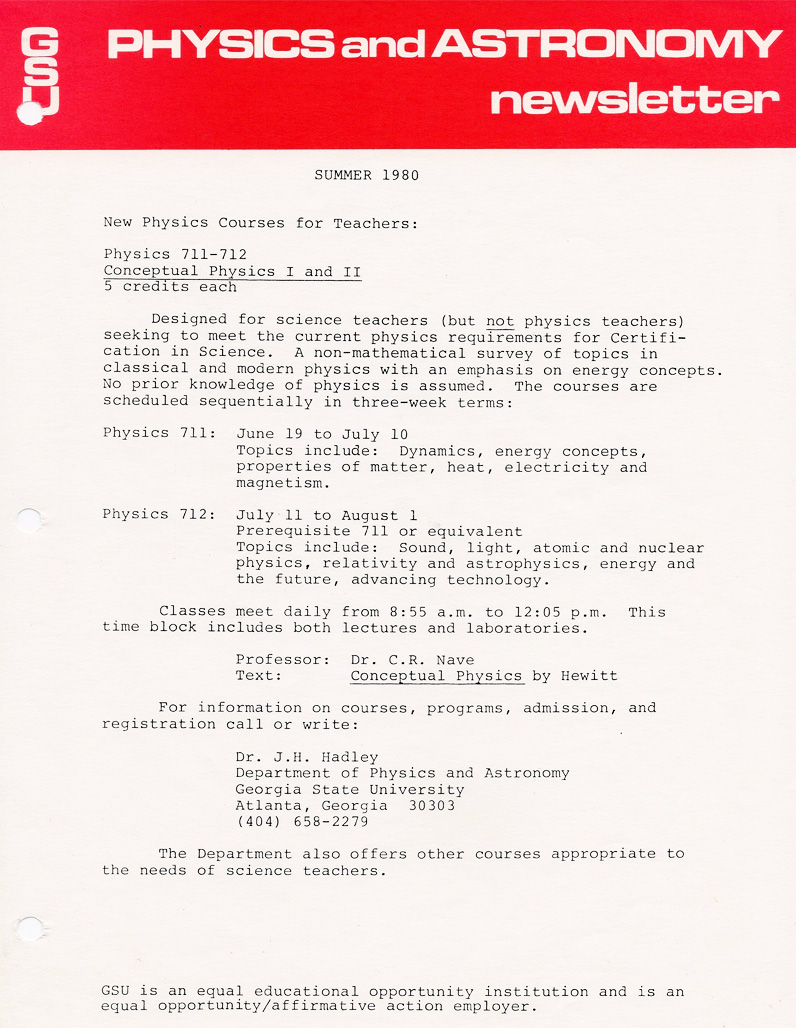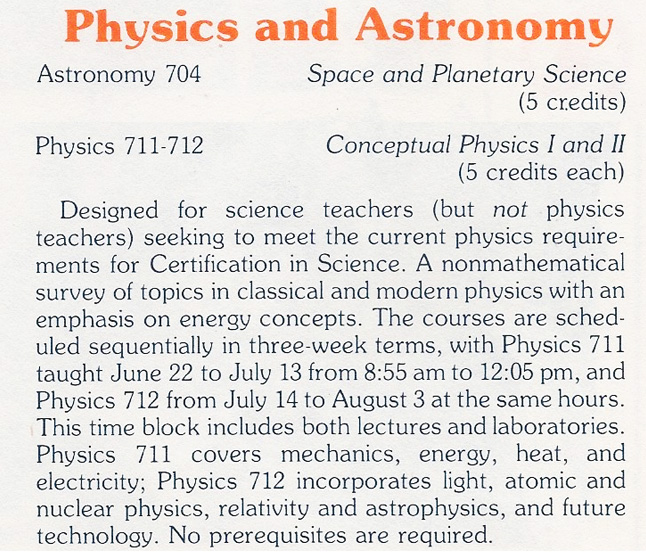Conceptual Physics and the Beginning of HyperPhysics
In early 1980, Dr Joseph H. Hadley, chair of the Physics department, approached me with a proposal that he had gotten from the College of Education. Because of movements going on in the state about a physics requirement for Certification in Science for teachers for high school and middle school, they felt like they needed a course in physics for those who were seeking a degree in science education. I developed an intensive overview course called Conceptual Physics, to be taught in two three-week courses meeting from 8:55am - 12:05 daily, including a laboratory. The course used the book Conceptual Physics by Paul Hewitt, whom I had talked with a number of times over the years at meetings of the American Association of Physics Teachers.

 | At left is the slightly more formal announcement for 1981. By 1982, Conceptual Physics was our major service course for the College of Education. |
Looking back on this development from the perspective of 2019, I taught the Conceptual Physics every summer except one until about 2010 when the Conceptual Physics was converted to an online course. Even though I formally retired in 2005, I continued to teach the Conceptual Physics in the summers until the conversion to online status, when it was taken over by John Wilson. The 30 year span of teaching Conceptual Physics hopefully was a benefit to all those generations of future teachers who took it, but it also had a major impact on me. There were vast changes in education during those three decades. The operational debut of personal computers for education occurred about 1982, and I almost immediately began introducing them into the Conceptual Physics course using the Apple II personal computers. Because they could be used to interface with experiments, I introduced computer based experiments using airtracks and collisions with photodiode switches for measuring times and velocities. In about 1986 the Apple Macintosh computer was introduced and I began to experiment with graphics on these computer screens and began producing handouts for Conceptual Physics using programs like MacPaint. In 1988 the vector graphics program Adobe-88 was introduced, to evolve into Adobe Illustrator, and that increased my capability for doing computer graphics and for making more detailed handouts. Another major computer development for Conceptual Physics was the introduction of HyperCard, an environment where one could make active graphics on the computer screen and actively link them to other screens, making possible an interactive teaching and learning environment. After learning the hypertalk language and the linking protocals, I plunged full force into creating an interactive learning environment which he called HyperPhysics because of the active linking text, called "hypertext".
Along with the development of the graphical interfaces for computers like the Macintosh, as well as for Microsoft Windows machines, there was great development in video for display on computers, so we began to include video segments for teaching, projecting them in the classroom. A new classroom and laboratory building, the Natural Science Center, was in the design stages, and I was able to win an instructional grant to set up a high technology classroom in that building, mostly based on the success and relevance of the courses for future science teachers. This building was completed in about 1991 and I was able to set up the classroom with computers and data interfaces for 12 stations the Rm 222 of the NSC. There was technology for projecting the computer screen and for projecting video, and it made major changes in the Conceptual Physics course.
During the 90s, the HyperPhysics on the HyperCard platform worked well in the classroom and I began to produce copies on CDs and distribute them. Since HyperCard was Macintosh only and the Windows graphic capability was coming along, I tried producing HyperPhysics on a Windows platform using Toolbook, but I had already experienced the loss of work done on proprietary platforms when they disappeared so I decided against a full effort on that platform.
A pivotal experience was the 1997 AAPT meeting in Denver. I was still producing HyperPhysics in HyperCard, but a group of us got together at that meeting to discuss strategy for making educational software and resources that would last. Many of us had lost work when the platform became obsolete. The world wide web was now a reality, having come into existence around 1992, and now it was being used for a lot of instructional material. The phrase that was used often in that meeting was "html is the clearing in the forest". With the fallen trees of obsolete platforms lying all around us, our consensus was that the language of the web, html, was going to last because it was the language of the web. I came home from that Denver meeting determined to explore html as a platform alternative to HyperCard.
The next year marked one of the remarkable and fortuitous coincidences in the development of HyperPhysics. It turned out that the language of the web, html, was remarkably similar in structure and logic to the hypertext markup language of HyperCard. It still took a lot of work, but by late in 1998, I had converted the bulk of the HyperCard development over to html. That involved not only learning the structure of html, but also learning the Javascript language to do the calculations that I had put into the HyperCard version. I placed the first version of HyperPhysics in html on the web in late 1998 and it almost immediately began experiencing a lot of traffic and use.
| Retrospective on HyperPhysics from 2016 |
| Second Edition of Physics for the Health Sciences |
1980